Dark Age of Camelot
This promising upcoming online role-playing game fuses traditional European mythology with tactical team-based combat. Enter the Dark Age of Camelot.
Dark Age of Camelot
Developer: Mythic Entertainment
Publisher: Mythic Entertainment
Release date: Fall 2001
By Andrew Park
Mythic Entertainment's Dark Age of Camelot is a fantasy-themed online role-playing game that pits elvish enchanters against dwarven berserkers and noble paladins. But it won't be based on generic high-fantasy archetypes. Instead, it draws upon traditional Celtic, British, and Norse mythologies. And instead of taking place in a completely fabricated world, Dark Age of Camelot will take place in a realm based on the northwestern Europe of Arthurian legend.
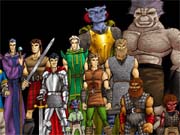
Dark Age of Camelot begins shortly after the fall of King Arthur and the dissolution of the Round Table. The three lands of the realm - Albion, land of the Britons; Hibernia, land of the Celts; and Midgard, land of the Norse - are thrown into turmoil without King Arthur's unifying rule. Without the guidance of a leader, the inhabitants of the realm find new conflict in their own lands. Roads that were once safe to travel are now patrolled by bandits, and fields that were once used to grow crops now lie in ruin from the raids of the strange new monsters that have begun to plague the countryside. The people of the three nations have come to realize that in such chaotic times, even greater things are at stake, namely each country's precious magical relics - the source of each nation's power. Above all else, these must to be kept safe from thieves and spies. And the realm must be unified again - through conquest. Fearless adventurers now prepare themselves to scour their own lands of beasts and brigands in preparation for a much larger task - assembling raiding parties to invade enemy lands, destroy their enemies in combat, and capture enemy relics.
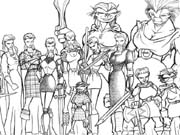
In the game, you'll be able to create characters of both human and completely nonhuman stock. When creating your character, you'll be able to choose from four different races in each of the three realms, for a total of 12 choices in all. Albion, Arthur's kingdom, is home to four different breeds of human: the well-rounded human Britons; the tall and powerful Highlanders; the swift and clever Saracens (who migrated to Albion generations ago in service of Arthur); and the mystical Avalonians, who are said to possess the power of Avalon's ancient magic. In contrast, the Celts of Hibernia don't live in highly civilized cities and towns, as they prefer to be closer to nature. Hibernia is home to Celtic humans; the gigantic Firbolg race; the swift and cunning Lurikeen humanoids; and the Elves, which are equally proficient in the use of arms and magic - both the magic of nature practiced by the Hibernian Druids and the ancient arcane magic of their elven forefathers. Finally, the Norse of Midgard are a rugged people, divided by the rocky land and their own inherently warlike nature. The Norse consist of the human Norsemen (and Norsewomen); the stout Dwarves, the hulking Trolls, and the small but swift Kobolds - a diverse group whose members are generally as suited to combat as they are to magic, which they derive either from the gods of Valhalla or from more primitive shamanistic rituals.
Next: Read all about character classes and more
Each realm will have eight character classes available to choose from. These generally consist of a pure melee fighter class, which cannot use magic spells of any kind but may use any weapon or armor and is most proficient in hand-to-hand combat; a hybrid magic user/fighter class; a thief class that generally wears medium to light armor and is more skilled at scouting and stealth than at combat; a bard class that has some moderate fighting ability, as well as the ability to affect his allies and enemies with magical songs; and various different types of spell-casting classes, including priests, wizards, and druids. In addition, some of the more specialized character classes are limited to specific races, and all character classes and races may join special in-game guilds to increase their existing skills and learn new ones.
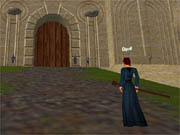
Albion's melee-oriented character classes include the weapon-toting Armsman; the noble Paladin, who is endowed with holy magic to complement his sword-arm; the stealthy Scout; and the wandering Minstrel. Briton characters may also be of a more magic-oriented nature, including the Cleric, whose divine magic enables him to heal and protect his companions, as well as see past illusions. Briton characters may also be Alchemists, Wizards, and Sorcerers. Theurgists are experts at manipulating ethereal spells into physical forms, including magical potions that grant additional powers to those who drink them. The Briton Wizard may only be of the Avalonian race, but he can use his great training to call forth the elemental powers of air, earth, fire, and water. And the Briton Sorcerer is something of a renegade magician - most of the people of Albion shun the mind-altering powers of the Sorcerer, though the few that do practice sorcery are capable of summoning powerful offensive magic that brings death and decay to their enemies.
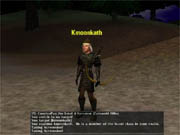
The Celts of Hibernia tend to favor the magic of nature over that of ancient tomes. The Hibernian melee classes include the Warrior, who, like the Briton Armsman, may not wield magic spells but is instead a master of arms and weapons; the Champion, a fighter that can also use magic to protect his companions and increase their proficiency in combat; the cunning Nightblade, who complements his stealth with a number of magical abilities including self-concealment and disguise; and the Hunter, a warrior of the wilderness who possesses some druidic healing and attack magic. Hibernians may also be Bards, who rely less on swords and heavy armor than Briton Minstrels and prefer instead to inspire their comrades and attack their enemies with magical songs. Finally, Hibernians may be Druids, Enchanters, and Eldriches. The Druid is the Celts' most powerful healer - druidic magic can directly heal the wounded and let them gradually regenerate lost health over time, as well as summon animal guardians. Hibernian Enchanters use their magic to enhance existing items, such as weapons and armor, and have some ability to create potions, magical traps, and alarms. They also have a knack for uncovering enemy traps. Hibernian Eldriches may be only of the elven race, but their power stems from the most ancient of arcane magic. As such, they wield considerable power on the battlefield.
Next: Read more about the classes
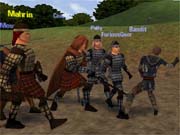
The Norse of Midgard are a rough people who favor combat at least as much as magic, if not more so. Such an outlook is pleasing to their warlike gods: Odin, the all father; Thor, god of thunder; and Hel, goddess of the dead. Norse melee characters may be Vikings, who eschew magic in favor of sturdy armor and weapons; and Thanes or Valkyries, who supplement their combat abilities with magic that aids both them and their entire hunting party. Norse characters may also be Rogues, dexterous characters that are as skilled with a sword as they are at hiding in the shadows and moving quietly, and Skalds, who are not only adept with weapons, but who are also skilled with songs that aid all who hunt with them and harm and hinder any nearby enemies who would oppose them. Norse characters may also be specialized priests of each of the three major Norse gods. Priests of Odin concern themselves with large-scale magic spells that heal and protect all members of the party, as well as control over animal wards, such as bears and wolves. Priests of Thor specialize in the magic of light and thunder, as well as the ability to change shape into animals; the legendary Wolsung, the children of Thor, were a clan of warriors that could change into the form of a great wolf at will. Priests of Hel are adept at inflicting magical damage upon their enemies by draining away their life force or by poisoning them with powerful venoms, and they are also skilled at calling forth the spirits and bodies of dead warriors to fight on their behalf. Norse characters may also be Runemasters, whose magic affects items such as weapons, armor, and magical traps. And the Kobolds of Midgard may elect to become Shamans, who use more primitive magic to attack their enemies with electricity and mind-based spells and to control the laws of motion by granting themselves additional mobility and hindering that of their enemies.
Regardless of what race or class you choose for your character, you'll be able to start your new life in one of the three realms and gain strength by fighting wandering monsters and hostile nonplayer characters, both on your own and in a hunting party. As long as you remain within the confines of your own realm, you won't have to worry about being attacked by other players, as your fellow countrymen may not attack you, nor you them.
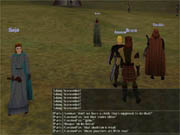
Then again, if you happen to wander too far out from the safer central regions of your home country to the wilder outlands, you may find yourself embroiled in a fierce battle for territory or for your nation's prized relics. That's because in Dark Age of Camelot, the key to unifying the realm is taking possession of all of its artifacts, especially those possessed by other nations. As such, you'll be able to rally your countrymen and form a raiding party to lay siege to enemy lands and seize their prized relics. Of course, you won't be able to do so without a fight. Once you've entered enemy territory, you'll be fair game for that nation's native species of monsters, its local guards, and most importantly, the player characters of that nation. One of the most important parts of a successful raid will be the capture of enemy outposts, where the computer-controlled guards of that nation stand ready to attack any outsiders. A clever and powerful raiding party will be able to overcome the guards and lay waste to the enemy outpost, then convert it to one of their own outposts, from which guards of their own country will emerge and guard the area. As such, attacking the site of an enemy relic will be a far more tactical affair than simply storming the castle, but such careful planning and strategy will be well worth the effort, since each of the relics conveys powerful advantages and added strengths to the adventurers of the nation that possesses it.
Dark Age of Camelot won't be released until next year, but the first round of beta testing for the game has already begun. We'll have more coverage as the development of this promising role-playing game continues.
Next: Go to our Dark Age of Camelot Q&A with Matt Firor
Q&A with Dark Age of Camelot Producer Matt Firor
We conducted a Q&A session with producer Matt Firor on the upcoming online role-playing game Dark Age of Camelot.
GS: Thanks for taking the time for this interview. Dark Age of Camelot is an intriguing game for a number of reasons, such as its use of specific mythologies. Could you please describe why this sort of setting was chosen for the game?
MF: You've hit on one of the most exciting parts of the game. We don't have to educate players about the back story of the game - everyone is already at least somewhat familiar with the legends and history of King Arthur, and to a lesser extent, Norse mythology and Irish legends. The game's title says it all: Dark Age of Camelot. What exactly did happen to Camelot after Arthur's death? Now online role-playing gamers have the opportunity not only to find out what happened - they can actually participate as well.
GS: In many online RPGs, one of the most severe consequences of foolhardy adventuring is death. How will death be handled in the game? Will your character lose experience, money, or possessions? Is it possible for players to lose entire experience levels to death?
MF: We're still working on many of the finer-point issues. After all, the game just went into its very first beta stage just last week. However, we have a rough idea of player death worked out. First and foremost, we want to encourage players to participate in player vs. player combat, so there will be no experience point or item loss if a player dies in player vs. player. In normal gameplay - such as when playing against monsters - there are a few options. The dead player can wait for a (high-level) Cleric to resurrect him with no point loss at all. He can wait for a lower-level Cleric to cast a "preservation" spell on him and drag him to an NPC healer and pay for a resurrection, again with no experience point loss. At the worst case, he can release and will come back to life at his last "bind" point. He will lose experience this way, but we'll make it so that experience point loss will be limited to a maximum of the points gained since the last level, so no player will ever lose a level as a result of death.
GS: One of the game's most distinctive features seems to be its team-based player vs. player system, especially the tactical issues of establishing outposts in enemy territory and capturing enemy artifacts. Could you please describe how it will work in the game?
MF: This is a very broad question, but it goes to the heart of what makes Dark Age of Camelot different from the other online RPGs out there. With Camelot, we solve the age-old problem of what to do once your character has been maxed out. We envision a normal character's experience to be much like EverQuest and Asheron's Call for the first 40 or so levels of his career, but at the point where the things start to get stale and boring in the other games, the Camelot player will be just hitting the next phase of his career: realm defense and invasions.
Next: What's a Realm?
The concept is that every player is a member of a realm. They are either a Briton from Albion, a Norse from Midgard, or a Celt from Hibernia. Each realm has its own distinct races and classes, drawn from the pages of that area's historical legends and mythology. Each has its own strengths and weaknesses (Hibernia specializes in magic, the Norse are the best fighters, and so on). Every character in the player's realm is his friend; he cannot fight or hurt them in any way. Every player in an opposing realm is his enemy, and he even appears as an NPC to him. These can be attacked on sight.
Each realm has a few relics, which are objects of power that give the realm a bonus to weapons and spell-casting ability when stored a special keep. These relics can be stolen from a realm by enemies and returned home to their keeps, which then confers the bonus to the invader's realm. It is up to the players of all realms to protect their relics, as well as go on invasions to steal those of the enemy realms. Each player class has a specific role to play in realm defense and invasion. Some classes are better at hiding, sneaking, and running, and some are better at casting defensive warding spells and traps.
There are also several keeps scattered about the frontier areas of each realm. These keeps can be controlled by whichever realm currently controls it. To take it over, all NPC guards and PCs have to be killed. Once this happens, guards of the victorious realm spawn there to help guard it - giving the victorious realm a base of operations to work from.
GS: One of the problems with player vs. player systems in the past is the inherent imbalance between powerful high-level characters and weaker low-level characters. How will you balance player vs. player so that more players will be encouraged to participate?
MF: A great question. There's nothing worse than player vs. player for no reason - rampant player killing has led to many people quitting some online RPGs. Our main goal in Camelot is to give a reason for player vs. player, a concept and back story that players can understand and then enforce. Each realm is geographically divided into two regions: a home region and a frontier region. The home region is very well protected by guards and other NPCs, and it will be very difficult for an enemy player killer to get into it. Low- and mid-level characters adventure here, relatively safe from marauding bands of realm enemies. The frontier region is a higher-level area populated by fewer friendly NPCs and many more aggressive monsters. It will be easier for enemy player characters to get here, so players adventuring in frontier areas have to be on the lookout for an invasion.
Each player will have to travel through his realm's frontier region to get to an enemy frontier region (after a boat ride, of course). So, most, if not all, realm combat will take place in these frontier regions, far from the cities and newbie areas, where low-level characters are. Any smart low-level character will not venture out of his home region until he is strong enough.
Next: Game geography and more
GS: If players don't want to participate in team player vs. player, will they be able to find enough to do in the meantime? Will they be able to take on quests or hunt monsters alone, or will they be forced to join raiding parties?
MF: Even though the focus of Dark Age of Camelot is team-based player vs. player combat, there will still be plenty to do for players who do not wish to participate in realm invasions. The frontier regions will fully support characters leveling up to the maximum (probably level 50), with commensurate dungeons, quests, and extremely high-level monsters. They'll be missing out on a lot of the fun by doing this, but it can be done, and we expect many to take this option. Of course, adventuring in the frontier regions carries with it some risk of random enemy PC attack, but if they steer clear of the boat landing areas and keep a watchful eye out, they should be able to avoid most enemy players.
GS: The idea of three distinct nations seems intriguing, but considering that each land is huge, and each of the nations is separated by water, how will travel be handled in the game? Will there be any sort of alternate means of travel, like teleportation? How will travel to an enemy nation be handled?
MF: The scope of the game's geography is huge. Each realm has a large expanse of territory to adventure in, even before the player starts exploring player vs. player. In order to get between the realms, there will be a boat system between the realms that carries players on invasions to the frontier regions of enemy realms. Travel in enemy nations will be on foot, and we are definitely planning on getting horses and mounted transport into the game - we just haven't worked out the details on that yet.
GS: We've heard that Dark Age of Camelot will also feature an extensive trade-skill system. Could you please describe how that system will work?
MF: Players will be able to craft just about any nonmagical armor and weapon that can be bought in a store. And player-crafted weapons and armor will be of better quality than those found in shops, making it advantageous to use items created by other players and giving a good reason for players to actively participate in their realm's economy.
Unlike in other games, weapons and armor in Dark Age of Camelot will deteriorate over time, requiring the player to sharpen his weapons and polish his armor from time to time, which requires skill. Eventually weapons and armor will become unusable, which means that players will be upgrading their weapons and armor constantly, giving them something to spend their money on and driving the economy. This will require a lot of tweaking, but we feel the underlying concept is quite sound - beta testing will let us know how we're doing on it.
GS: Is there anything else about Dark Age of Camelot you'd like to mention?
MF: Only that we're making great progress and enjoying seeing the enjoyment gotten out of the game by the testers, even at this extremely early stage.
Got a news tip or want to contact us directly? Email news@gamespot.com
Join the conversation